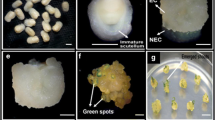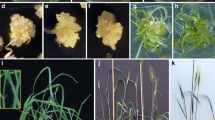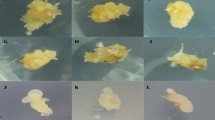Abstract
Forty-eight bread wheat (Triticum aestivum L.) released cultivars and elite advanced lines were evaluated for their ability to produce embryogenic callus using three different media. Basal N6 medium supplemented with dicamba (E1), MS medium containing 2,4-D (E3) or MS medium containing 2,4-D plus different amino acids (E5) were used for callus initiation and maintenance. Plant regeneration was achieved on basal MS medium with indole-3-acetic acid (IAA) and 6-benzylamino purine (BAP) and rooting on MS with 1-naphthaleneacetic acid (NAA). Percentage regeneration varied widely with both genotype and initiation medium, with values ranging from 2% to 94%. The number of plantlets produced per embryo ranged from 6 to 42. Thirteen genotypes showed at least 50% regeneration after culture on E5 medium; 3 genotypes after culture on E3 initiation medium and 1 after initiation on E1. After four subcultures, over a 16-week period, 41 genotypes (85%) lost their ability to regenerate plants while the remaining 7 lines (15%) retained plant regeneration potential but at reduced levels. E3 medium was found to be the best for maintaining regeneration potential after four subcultures.
Similar content being viewed by others
References
Ahloowalia BS (1982) Plant regeneration from callus culture in wheat. Crop Sci 22:405–410
Ben Amer IM, Worland AJ, Schlegel R (1992) In vitro culture variation of wheat and rye caused by genes affecting plant growth habit in vivo. Euphytica 61:233–240
Bohorova NE, van Ginkel M, Rajaram S, Hoisington DA (1995) Tissue culture response of CIMMYT elite bread wheat varieties nd evaluation of regenerated plants. Cereal Res Comm (in press)
Carman JG, Jefferson NE, Campbell WF (1988) Induction of embryogenic Triticum aestivum L. calli. I. Quantification of genotype and culture medium effect. Plant Cell Tissue Org Cult 12:83–95
Chu CC, Wang CC, Sun CS, Hsu C, Yin KC, Bi CV (1975) Establishment of an efficient medium for anther culture of rice through comparative experiments on the nitrogen source. Sci Sinica 18:659–668
Elena EB, Ginzo HD (1988) Effect of auxin levels on shoot formation with different embryo tissues from a cultivar and a commercial hybrid of wheat (Triticum aestivum L.). J Plant Physiol 132:600–603
Felsenburg T, Feldman M, Galun E (1987) Aneuploid and alloplasmic lines as tools for the study of nuclear and cytoplasmic control of culture ability and regeneration of scutellar calli from common wheat. Theor Appl Genet 74:802–810
Gale MD (1979) Genetic variation for hormonal activity and yield. In: Spiertz JHJ, Kramer Th (eds) Crop physiology and cereal breeding. Centre for Agric Pub and Documentation, Wageningen, The Netherlands, pp. 29–34
Galiba G, Kovacs G, Sutka J (1986) Substitution analysis of plant regeneration from callus culture in wheat. Plant Breed 97:261–263
Gosh-Wackerle G, Avivi L, Galun E (1979) Induction, culture and differentiation of callus from immature rachises, seeds and embryos of Triticium. Z Pflanzenphysiol 91:267–278
He DG, Yang YM, Scott KJ (1989) The effect of macroelements in the induction of embryogenic callus from immature embryos of wheat (Triticum aestivum L.) Plant Sci 64:251–258
Higgins P, Mathias RJ (1987) The effect of the 4B chromosomes of hexaploid wheat on the growth and regeneration of callus cultures. Theor Appl Genet 74:439–444
Hunsinger H, Schauz K (1987) The influence of dicamba on somatic embryogenesis and frequency of plant regeneration from cultured immature embryos of wheat (Triticum aestivum L.). Plant Breed 98:119–123
Kaleilau EK, Sears RG, Gill BS (1989a) Monosomic analysis of tissue culture response in wheat (Triticum aestivum L.). Theor Appl Genet 78:783–787
Langridge P, Lazzeri P, Lörz H (1991) A segment of rye chromosome 1 enhances growth and embryogenesis of calli derived from immature embryos of wheat. Plant Cell Rep 10:148–151
Lazar MD, Collins GB, Vian WE (1983) Genetic and environmental effects on the growth and differentiation of wheat somatic cultures. J Hered 74:353–357
Maddock SE, Lancaster VA, Risiott R, Franklin J (1983) Plant regeneration from cultured immature embryos and inflorescences of 25 cultivars of wheat (Triticum aestivum). J Exp Bot 34:915–926
Mathias RJ, Atkinson E (1988) In vitro expression of genes affecting whole plant phenotype — the effect of Rht/Gai alleles on the callus culture response of wheat (Triticum aestivum L.em. Thell). Theor Appl Genet 75:474–479
Mathias RJ, Fukui K (1986) The effect of specific chromosome and cytoplasm substitutions on the tissue culture response of wheat (Triticum aestivum) callus. Theor Appl Genet 71:797–800
Mathias RJ, Simpson ES (1986) The interaction of genotype and culture medium on the tissue culture responses of wheat (Triticum aestivum L.) callus. Plant Cell Tissue Org Cult 7:31–37
Mounla MAKh (1979) Phytohormones and grain growth in cereals. In: Spiertz JHJ, Kramer Th (eds) Crop physiology and cereal breeding. Centre for Agric Pub and Documentation, Wageningen, The Netherlands, pp 20–28
Murashige T, Skoog F (1962) A revised medium for rapid growth and bioassays with tobacco tissue cultures. Plant Physiol 15:473–497
O'Hara JF, Street HE (1978) Wheat callus culture: the initiation, growth and organogenesis of callus derived from various explant sources. Ann Bot 42:1029–1038
Ozias-Akins P, Vasil IK (1982) Plant regeneration from cultured immature embryos and inflorescences of Triticum aestivum L. (wheat): evidence for somatic embryogenesis. Protoplasma 110:95–105
Ozias-Akins P, Vasil IK (1983) Improved efficiency and normalization of somatic embryogenesis in Triticum aestivum (wheat). Protoplasma 116:40–44
Sears RG, Deckard EL (1982) Tissue culture variability in wheat: callus induction and plant regeneration. Crop Sci 22: 546–550
Shimada T (1978) Plant regeneration from the callus induced from wheat embryos. Jpn J Genet 53:371–374
Shimada T, Yamada Y (1979) Wheat plants regenerated from embryo cell cultures. Jpn J Genet 54:379–385
Waller RA, Duncan DB (1969) A Bayes rule for the symmetric multiple comparison problem. J Am Stat Assoc 64:1484–1503
Author information
Authors and Affiliations
Additional information
Communicated by Y. Gleba
Rights and permissions
About this article
Cite this article
Fennell, S., Bohorova, N., van Ginkel, M. et al. Plant regeneration from immature embryos of 48 elite CIMMYT bread wheats. Theoret. Appl. Genetics 92, 163–169 (1996). https://doi.org/10.1007/BF00223371
Received:
Accepted:
Issue Date:
DOI: https://doi.org/10.1007/BF00223371




